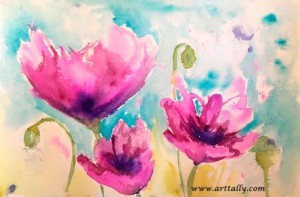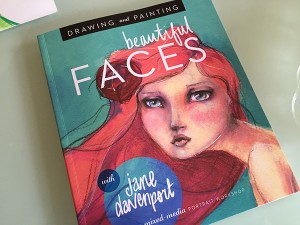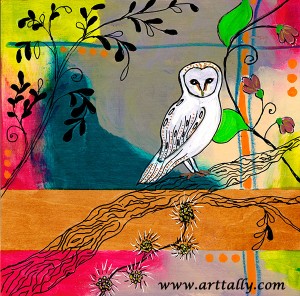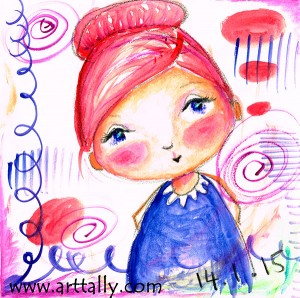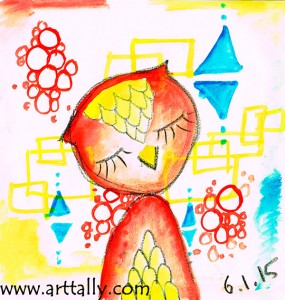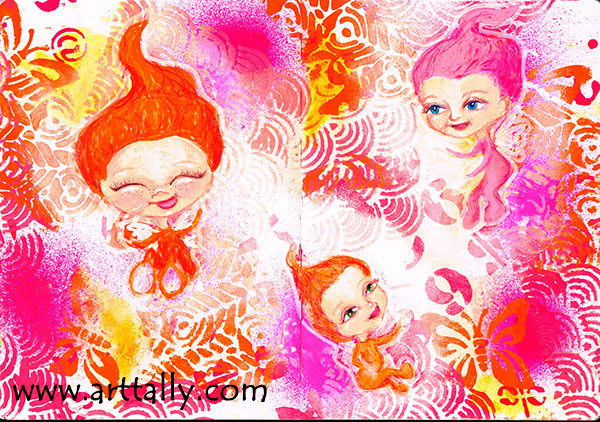Should a beginner buy expensive paint?
I have to say I am loving my Schminke watercolour paints. I spent a long time pondering whether it really did make a difference using the 'artist quality' version of the paints as opposed to the 'student quality'. It is always a rather tough call when you are starting out.
When you know you are just learning it is hard to justify expensive paint. It is something of a widely held notion that you first 100 paintings are going to be rubbish - it is just something you have to work through. (Actually some say 500.... lets be gentle and start with 100). If you are interested in this idea, you might want to check out Lynn Whipple's rather charming short video on the matter.
Expecting a few dodgy paintings inevitably leads to some reluctance about splashing out on professional paint. However, doesn't a beginner need all the odds stacked in their favour? Such as paint that behaves the way it is supposed to? Glorious, vibrant colours?
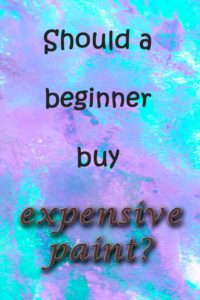 So should a beginner buy expensive paint? There is is no easy answer to the dilemma. I think that the deciding factor within the available budget is whether the 'good' paint will inspire or inhibit you. If you will be happy to splash it about in your early experiments then I say go for it. But if it is going to make you even more critical of your early efforts and cause you to agonise over every brush stroke then it rather defeats the purpose. Sometimes it is easier to give yourself permission to be a beginner if you are not worrying about wasting supplies. (And by the way, if it is fun, it is not a waste, regardless of your opinion of the final output.)
So should a beginner buy expensive paint? There is is no easy answer to the dilemma. I think that the deciding factor within the available budget is whether the 'good' paint will inspire or inhibit you. If you will be happy to splash it about in your early experiments then I say go for it. But if it is going to make you even more critical of your early efforts and cause you to agonise over every brush stroke then it rather defeats the purpose. Sometimes it is easier to give yourself permission to be a beginner if you are not worrying about wasting supplies. (And by the way, if it is fun, it is not a waste, regardless of your opinion of the final output.)
The main thing is to get on with those paintings. Whether you use cheaper paint or professional quality paint doesn't really matter. It only matters that you give yourself the chance to paint yourself happy.
Watercolour poppies for beginners
I found a really fun video on You Tube for today's watercolour flowers. Loose, happy poppies sitting on some grass painted with a straw - yes a straw!
Having access to so many ideas and techniques relating to whatever we want to learn is obviously brilliant. However, I am painfully aware that it is also something that stops us from taking action. It is very much easier to watch some one else paint than to get out all the supplies and have a go yourself. Especially if you suspect it will probably not turn out looking much like the one in the video. And of course, You Tube will then offer you all sorts of other similar videos to watch. Before you know it, you have spent the day watching lots of other people skillfully practicing something you wanted to do.
What a fascinating irony that the videos designed to teach us to paint something can also be the very thing stopping us from doing any actual painting ourselves. I fall prey to this all the time, but today I can say, (with a little less hypocrisy) switch off the video and get out your paints!
By the way, if you would like to paint along (or just watch and think about what it would be like to paint along..) here is the link to some watercolour poppy paintings for your viewing pleasure, including the one with the straw.
If you are a budding painter looking for a quick, manageable project, I think you will enjoy these watercolour poppies for beginners. The video is a fun introduction to painting without a pencil sketch (be brave, you can do it!), painting wet in wet, and using some less conventional painting tools.
And if painting flowers in watercolour is your thing, how about painting these joyful hydrangeas?
This is an easy painting project for a beginner. Learn all my tips and tricks to loose expressive watercolour painting in this real time narrated video tutorial lesson.
( No drawing is required - I’ve done that for you! )
Click on the button above and start painting loose hydrangeas today!
How to manage your inner critic
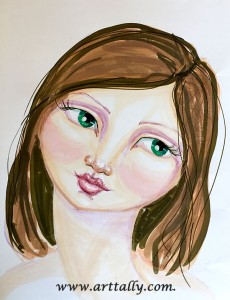 I was supposed to post Face no 12... this one above, yesterday. I drew her. I was not pleased. I decided to begin again. Having completed Face no 13, I concluded she was worse than Face no 12. Ah, the inner critic.
I was supposed to post Face no 12... this one above, yesterday. I drew her. I was not pleased. I decided to begin again. Having completed Face no 13, I concluded she was worse than Face no 12. Ah, the inner critic.
When the inner critic pipes up with her judgement, it is easy to feel paralysed. To just stop seems an easier, and far more sensible solution than to continue.
 The inner critic is a defense mechanism. Her aim is to reduce our risk. To prevent us from being judged by others, and possibly hurt in the process. However, despite these good intentions, sometimes she succeeds only in strangling the muse, and any motivation to act on any creative urge.
The inner critic is a defense mechanism. Her aim is to reduce our risk. To prevent us from being judged by others, and possibly hurt in the process. However, despite these good intentions, sometimes she succeeds only in strangling the muse, and any motivation to act on any creative urge.
Learning how to manage your inner critic stems from that awareness. Knowing that it is a protective mechanism we can acknowledge and appreciate the self care intention. From this much gentler place we can assess more rationally the seriousness of the risk perceived by the inner critic.
To make that evaluation you need to return to your 'why'. Why are you creating? There are a host of valid reasons. In fact, I don't think I can think of an invalid one. But the mere fact that you began the creation process suggests that it is a necessary self expression. We all have the right to express ourselves, regardless of our talent or ability. To create just for the sake of creating. As the creator, your job is to create, not to judge the creation.
Create because you feel the inclination to create.
Create because it gives you joy.
Create for the delight of the process.
Let the output of your creative process be whatever it will be. Inevitably, with practice you can only become better. But if you let the inner critic thwart your process in the early stages, you will never get to see that for yourself.
Learning to draw different facial expressions
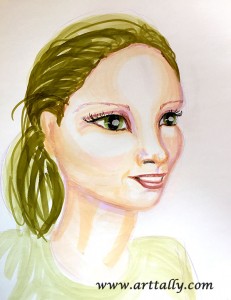 Drawing faces is becoming something of a passion of mine. That is not unusual. Portraits have been a popular subject choice for artists for as long as we have been drawing.
Drawing faces is becoming something of a passion of mine. That is not unusual. Portraits have been a popular subject choice for artists for as long as we have been drawing.
For many of us making art is a way of understanding ourselves and each other. Our faces are what we present to the world. Whether they reveal or conceal our innermost thoughts and feelings, faces can be endlessly fascinating.
Spending time learning to draw different facial expressions and even just different faces is time available to observe and contemplate. That feels like a privilege. I'm sure there is no substitute for a live model, but an ample supply of patient and willing models is not so easy to come by. Not everyone is comfortable with your intense and enduring scrutiny... funny that...
I have learned of a great resource to overcome this particular problem. Mark Simon has developed a series of books that contain photo references - especially made for all types of artists. There are books of adults from 20-83 years of age as well as a book of children from babies to young adults. The books show multiple expressions and angles of each face. Invaluable whether you are learning to draw faces as a beginner, or learning to draw facial expressions, or even if you are a professional needing to draw particular phonemes for animation or graphic novels.
I bought the book with children in it as they are my subject preference. The book is large and feels like a substantial support to my endeavours! At first I was a little disappointed because the cover is in colour and glossy but the interior pages are all in black and white. I soon realised, however, that this is in fact very useful. It is so much easier to see value contrast in a black and white photo. And since I seem determined to give all my subjects green, blue or pink hair, I am hard pressed to think why I would even want to see the photo in colour in the first place.
So, if you are looking for some inspiring faces to draw, check out these books. Yes, I know. There is Pinterest, of course. But for a variety of ages, and expressions over consistent faces, you can't beat a nice sturdy printed book. That's what I think.
Beautiful eyes
"For beautiful eyes, look for the good in others; for beautiful lips, speak only words of kindness; and for poise, walk with the knowledge that you are never alone." - Audrey Hepburn
I love drawing beautiful eyes. In fact I think the eyes are the reason I draw faces in the first place.
Jane Davenport did a recent video for the documented life project - all about eyes. It is fascinating to watch her pull these eyes out of the page... check it out here.
A little help starting the creative process
 I have learned that you often need a little help starting the creative process. There can be a sort of inertia to overcome. Steven Pressfield calls it Resistance.
I have learned that you often need a little help starting the creative process. There can be a sort of inertia to overcome. Steven Pressfield calls it Resistance.
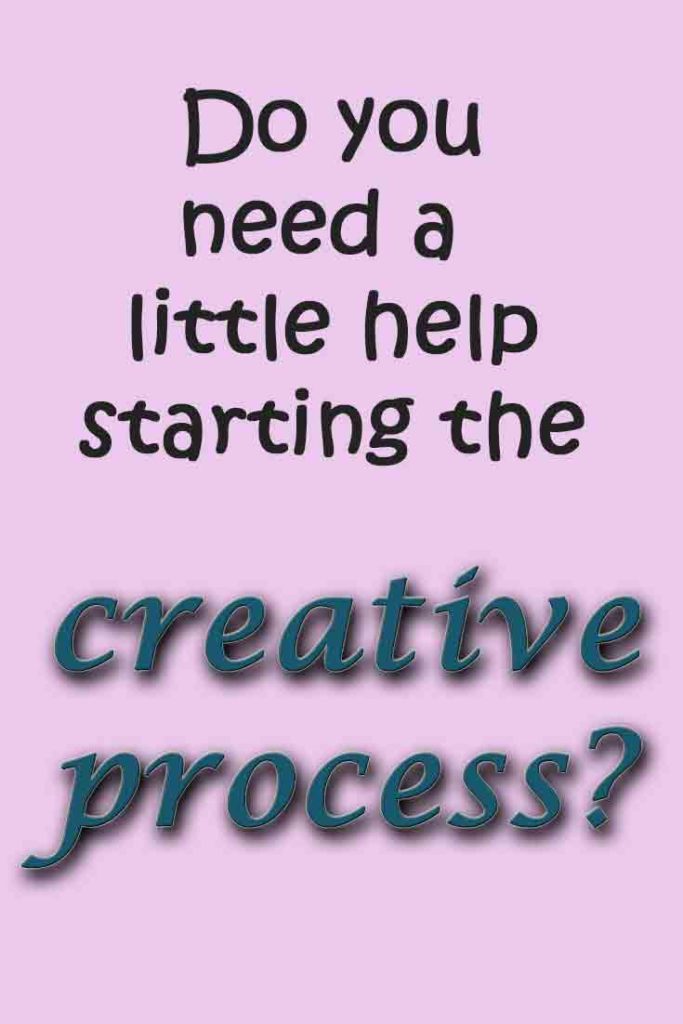 To me it is often just the seemingly insurmountable question of where to begin. Jane advises her students to copy with abandon in the interests of learning - not of course, to pass off these copies as one's own, but to start somewhere. To draw something.
To me it is often just the seemingly insurmountable question of where to begin. Jane advises her students to copy with abandon in the interests of learning - not of course, to pass off these copies as one's own, but to start somewhere. To draw something.
If I am drawing faces, then I can't help but start with Jane Davenport. I am loving her book... this one...
One of the things that troubles me is having all my faces turn out the same. Often quite pretty, but with something of a vacant stare. And once you get used to drawing a particular angle or pose it is very easy to get stuck in a rut.
So today I started out with a face and a bit of a body from the early part of Jane's book. It's quite a surprise how far away you can get from your original inspiration source. This particular page gave me a nice face shape to start with. Braids - I liked those. And a lovely languid pose. But by the time I was done choosing marker colours without thinking too much she turned out with a completely different feeling about her compared to the girl on Jane's page.
What a relief that a little bit of ourselves can't help but ooze out - even when we start from the very same point as somebody else.
Learn to draw faces
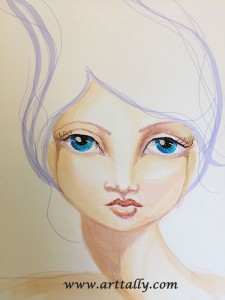 New month - new series! August is going to be all about faces. I have been enjoying drawing teapots but found myself wanting to put faces on them. So I have decided to spend August working on faces.
New month - new series! August is going to be all about faces. I have been enjoying drawing teapots but found myself wanting to put faces on them. So I have decided to spend August working on faces.
One of the first things I learned to draw was faces. Whimsical faces. 'Jane style'. And one of my favourite ways to draw faces is using alcohol markers - something else Jane introduced me too. There is nothing quite like them for making creamy skin tones.
Today I started with Jane's book on drawing beautiful faces. I started, of course, at the section that shows you how to draw a face step by step using markers. This is my version. I am using Spectrum Noir markers. They are the cheaper brand of alcohol markers, but as long as I use proper marker paper, I find that I rather love them. They don't have the brush tip unfortunately, just the chisel but I seem to be okay with that too. After all, significant precision is just not my style!
I highly recommend learning to draw faces. With a few good tips, it is really not as hard as you might think. I started off with Draw Happy, one of Jane's workshops which introduces face drawing. Then I was hooked and did more of her courses that cover faces.
Faces are fascinating. We communicate so much with our faces, even if we don't intend to. So being able to draw a face feels somehow empowering.
Studying faces and expressions to be able to draw them has made me a little more perceptive I think. It certainly makes me really notice someone who is talking to me. I'd like to say that it makes me more present. I think on a good day, it does. But it is also possible that I missed what they were saying because I was trying so hard to observe and remember the tiny expressive crease of brow, a particular dimple that appears only for a certain type of amusement, or the shapes made by shadows falling across the face.
It's all good. It's these tiny details of every little part of our lives that makes them worth living, I think.
Tea and lettering
If you love tea, and quotes and doodling it doesn't take long before you put them all together.
If you think you would like to have a go at doodling some letters - and why wouldn't you? Its easy, fun and doesn't require that you know how to draw!... Anyway, if you wanted to have a go, I recommend checking out one of my favourite online teachers Joanne Sharpe. She has several lettering classes available. Joanne has a delightful manner and her classes are accessible and broken down into short managable video lessons.
I have written about her before, so if you want to find out more about her classes you might want to read this next.
Explore more of the Tea Time post series here
See the kitchen inspired artwork available in the shop today
The best watercolour brush for beginners
Watercolour is fast becoming my favourite medium. I can't say it is easy - acrylic paint is far more forgiving I think. If you are just getting started with watercolour it is easy to get discouraged. If that resonates with you, I have two suggestions that might be helpful. They relate to one of the most important watercolour supplies for beginners. A great brush. The best watercolour brush for beginners can make all the difference when it comes to enjoyable painting.
Luckily, a good brush doesn't mean an expensive brush necessarily. When I started out I had a set of paints which came with a brush. I always wondered when to spend more money on a brush or if it was even necessary. It felt like a cop out - you know, a bad workman blames his tools. But there is always that little shred of hope - perhaps my painting would be so much better if I had a better brush....?
I now have a brush which has become the only brush I want to paint with. It is a Princeton Neptune Round No 12. Yes, that is quite a big brush. The thing about a good brush though, is that it holds its point well. That means that if you just use the very tip of the brush, and hold it vertical to the paper you can achieve a lovely fine line - even with a number 12. So my first suggestion is to find yourself one of these brushes. They are not too expensive and a total joy to paint with.
The second thing you can do to help yourself is to learn how to use this brush.
I think one of the easiest ways to do this is to watch someone else using it. One of my favourite You Tube teachers is Angela Fehr. She is also a fan of this very same brush, and recently put out a video which demonstrates some easy some leaf painting. Angela makes watercolour painting seem much more approachable. Check out her video here.
Explore more of the Tea Time post series here
See the kitchen inspired artwork available in the shop today
Learn to draw for fun - no pressure, no expectations
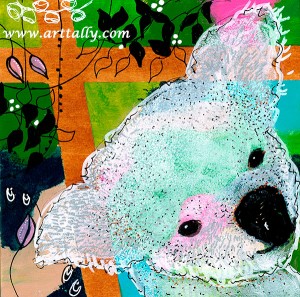 I believe anyone can learn to draw. Drawing is so good for us. It teaches us to be mindful, observant. It helps us slow down and unwind. Its also a really fun thing to do.
I believe anyone can learn to draw. Drawing is so good for us. It teaches us to be mindful, observant. It helps us slow down and unwind. Its also a really fun thing to do.
Although maybe not so much when you are first starting out. The problem with learning new things is that we often fail to give ourselves permission to be beginners. Being bad at something doesn't feel excellent. But being bad at something is the first step towards being good at it.
I don't think you need to actually be good at it to reap some of the wellness benefits. Doing something with your hands is a good way to come back to the present. To spend some time doodling is a helpful way to switch off, perhaps after work, or if you have trouble falling asleep.
Drawing is a skill anyone can learn. There are techniques and rules that anyone can learn and with enough practice become proficient. Its a question of how many hours you are prepared to put in.
Those early hours are the tough ones. Like learning anything new, the first attempts can be almost painful - just think about what it's like to have your first few lessons with a new musical instrument! Even learning to drive has similar problems - you need to know so much at once to be able to execute the task.
However, the internet provides us adult learners with a rather marvelous opportunity. You can learn almost anything in the privacy of your own home and often enough, for little or no cost. Thank you, You Tube!
Drawing is no exception. I reckon the best way to start to learn to draw is to dig out that old bic from the bottom of your handbag, grab a scrap of paper that was already on its way to the recycling bin and have a doodle. Why not?
Don’t agonise over which supplies. Don’t go and purchase a fancy new sketchbook. These things ramp up the expectations you have of yourself and turn something that could be just a bit of relaxing fun into a Big Thing.
Need some inspiration? A bit of helpful instruction? Your smartphone is close to hand, I bet…. Many lovely teachers are just waiting for you. It was tricky to narrow down the list but here are three of my fave You Tube drawing teachers:
1. Learn to draw with Alphonso Dunn
Alphonso provides weekly videos on how to draw everything. No really, that is his tagline. I would suggest heading to the playlists and going for something like the ‘how to draw everything else under the sun’ playlist. There is a drawing fundamentals playlist. My suggestion is not to start there. Time for that later. This is just supposed to be fun. It's not school. Choose a short video - 5 minutes or so. How to draw an asteroid perhaps? A raindrop?
2. Learn to draw with Art a la Carte
Art a la Carte also provides weekly art videos for all ages and skills. You might find more of the cutesy stuff over here… cartoon kitty cats for example. Fun!
3. Learn to draw with Fine art tips
Sometimes when I feel a bit tired of drawing (what? Tired of drawing??) I find almost as much enjoyment in watching someone else draw. There is something soothing and absorbing about watching someone skillfully pull a three dimensional image out of a flat empty page. I love watching the image gradually emerge. Oh, and the sexy accent doesn’t hurt….
So what are you waiting for? Let's draw something!
Use your artist's eyes to find a little more daily happiness
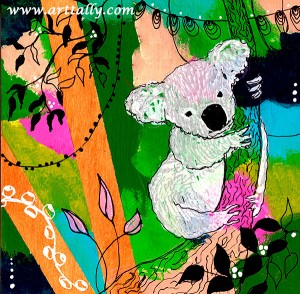 It is a privilege to be able to see the world through artist's eyes. The same privilege as it is to see the world through the eyes of a child. Have you ever taken a walk with a three year old? In 100m there will be a surprising amount of fascinating diversions. Every ant, shadow and unusual shaped leaf can absorb and entertain a child. We probably don’t even notice these things.
It is a privilege to be able to see the world through artist's eyes. The same privilege as it is to see the world through the eyes of a child. Have you ever taken a walk with a three year old? In 100m there will be a surprising amount of fascinating diversions. Every ant, shadow and unusual shaped leaf can absorb and entertain a child. We probably don’t even notice these things.
But if you are open to it, as we all are as children, there is awe and beauty in every dewdrop balanced on a leaf tip, the shafts of new light through the trees, the contrast of red and gold autumnal leaves against a perfect blue sky.
Finding the joy in these things is the path to a little more happiness in every day. Far more so than in the ‘big’ things, like winning the lottery or getting that promotion.
If you want to reawaken that child-like awe, the easiest way to do it so to draw something. You don't need to draw well, you just need to practice using your artist's eyes. And yes, we do all have artist's eyes, whether you believe it or not.
Drawing is 90% looking and 10% drawing. It requires the abandonment of judgement and preconception. You know that the your teacup is round but right now, from this angle, the rim actually looks like an oval. You know mountains don’t really have blue grass but right now those mountains do indeed look blue .
Being required to see things just as they appear rather than how you think they are supposed to be, forces you to really notice your world. If you draw and paint regularly you start to see the world in all its glory again. The shadow pattern made on the carpet by the light from the window can somehow enthrall. The arrangement of a throw, a pillow and book tossed on your chair in the living room delights. Maybe it's the composition. Maybe it is the marriage of colours - quite coincidental but even more lovely for it. These small things are enough to lift your spirits just that little bit.
In a world that bombards us with a constant stream of usually less than positive news events, the little dose of happy to be found in every part of our environment is just the counterbalance we need.
12 things you want to know about acrylic paint
If you are getting started with painting there are 12 things you want to know about acrylic paint:
It washes up with water - no smelly, toxic solvents required as may be the case with something like oil
It is very forgiving - you can paint over anything you want to change or adjust very quickly. Acrylic paint has excellent opaque coverage so even if you have a deep purple area you can paint over it with a pale colour or even white and it will be completely covered - this is not the case with watercolour!
Your finished painting is completely dry straight away - unlike oil paintings where some museum curators will not consider the painting totally dry until it is 50 years old
You can paint on almost anything - acrylic paint is made of pigment suspended in water and mixed with an acrylic binder. Yes, that is basically plastic! Paint on paper, canvas or wood like my little whale
Acrylic paint comes in marker form - hurrah! There are several brands available now such as Posca, Molotow and Montana. Some of these markers are even refillable. They come in different nib sizes and shapes, even brush tips. I used acrylic markers for the whale and the doodles in the picture in this post as well as all my paintings in the animal panel series.
You can make it translucent for glazing - You can mix it with a matte or gel medium which is really just pigment free paint. This will make it more translucent and enable you to make glazes over the top of your existing work
You can add texture and/or increase the drying time. While fast drying time is often described as an advantage, you may want to work wet in wet and blend the paint like an oil painter. You can still do this with acrylic paint by adding the right medium to it. Many different acrylic mediums are available eg, texture paste, flow medium
Acrylic paint plays so nicely with other art supplies. If you choose a particularly matte acrylic paint you can use your coloured pencils over the top. Try it out with watercolours too.
It is still relatively 'new' as art media goes. This means we don't really know how it is going to stand the test of time
It was first created in the lab in 1901 by Dr Otto Rohm
in the 1950s acrylic paint was commercially produced as interior house paint
Early adopters of acrylic paint in the art world include Moris Louis, Kenneth Noland, Mark Rothko, Robert Motherwell, Barnett Newman, Roy Lichtenstien, Andy Warhol and Bridget Riley.
Painting on wood
I have been loving painting on wood. It felt like a very modern thing to do. How wrong I was about that!
A very brief history lesson
Apparently, wood was the substrate used by most artists until the 16th century. It was a very prestigious medium in Greece and Rome. The oldest surviving Greek paintings are a series of 6th century BC painted tablets from Pitsa.
The old masters painted on many different types of wood, depending on what was locally available. For example, Albrecht Dürer (1471–1528) painted on poplar when he was in Venice and on oak when in the Netherlands and southern Germany. Leonardo da Vinci (1452–1519) used oak for his paintings in France. Hans Holbein (1497/8–1543) used oak while working in southern Germany and England.
The move towards canvas
In the 16th century, canvas began to gain popularity in Venice. Italians were making the best quality canvas at that point, for sails. Mantegna led the change from wood to the cheaper and more portable option of canvas.
Canvas has been the substrate of choice for all serious works of art since then. However, wooden panels have seen something of a renaissance recently and are being recognised as one of the most durable and archival supports available to painters today.
The advantages of painting on wood
I love wood because of its smooth surface. It feels more like working on paper than canvas does. The smoothness and firmness means that it is easier to use many different media on wood compared to canvas. For me, this increases the level of detail I might be able to achieve. I also appreciate the greater freedom this accords me when correcting for those little 'accidents' happy or otherwise.
You can even use watercolour on wood.
Sourcing wood for painting
I do understand that since it is only wood, it is possible to paint on any piece of wood. That is just a little bit too much effort prior to getting into the fun of painting for my liking. If you are more patient and skilled at carpentry than I, you can find your own wood, or even hardwood and gesso it to create a lovely solid, smooth painting surface. Lori McNee demonstrates in this video, if you are interested.
But my preference is for ready-to-go cradled wood panels. I kept seeing artists using them in my online travels and they appear to be easily available in America and Europe. However, I live in Australia, and they have been hard to find out here. I have finally found some (obviously...) Cavalier Art ship Australia wide, as far as I understand, so if you are a fellow Aussie that might help you out.
I rather like that what was old is now new again. I am happily embracing wood panels and looking forward to experimenting a bit more with them. Hopefully, you will too!
Learn to illustrate with Danielle Donaldson
Creative Girls with Danielle Donaldson
I have been taking Danielle Donaldson’s delightful class at the Jeanne Oliver network. I have always loved drawing little characters and I have been trying to learn to illustrate by taking classes with as many different people as possible so that my own characters eventually find their own style. I am enjoying watching how my girls morph from Jane Davenport girls to Juliette Crane girls to Danielle Donaldson girls. I think with each transformation they retain a little something from each experience. I am fascinated to see how they end up. Maybe there is no ‘end’. Perhaps the point is that our drawings taking on a life of their own and perpetually evolve. I like that idea.
What is in the class?
This course covers character building, journal making, a little lettering and perspective and is mainly using watercolours which I am currently in love with. (Mercifully, as I was off to a bit of a rocky start with an early attempt at ‘traditional’ watercolours!)
Here are my Danielle-ish girls. I even played with my twinkling H2Os for the first time. Danielle doesn’t use those in the course - I just couldn’t resist giving the girls a bit of bling in a rather subtle way. Hmm.. Is that possible?…subtle bling?
Themed journals
I love the idea of a themed journal like this one that Danielle teaches you to put together. I didn't opt to bind my own journal although I do love doing that too. At the moment I have set my book up as Danielle instructs and I am trying not to feel scared of messing it up… I’m working in pencil like Danielle which is unusual for me - never been a fan of graphite but… yippee, you get to erase!
Cover Girls
Danielle’s cover girl is a character called Bad Penny. She is super cute. However, I couldn't quite bring myself to call any of my characters ‘bad’ … so I have a different Danielle-ish girl. I have popped her on the first page in my journal. I might recreate her on a separate sheet and stick her onto the cover of my journal eventually.
Working small
The course also teaches you to work small to build up confidence in developing illustration skills. This is an idea close to my heart, as I first learned the appeal of working in a teeny journal when I took one of Joanne Sharpe’s classes Draw Your Awesome Life, which I also highly recommend.
Perspective
Another part of the class I have really enjoyed is learning perspective. Danielle incorporates just enough of the technical skills of perspective to really help make more lively, realistic (and yet still whimsical) drawings. There is not so much of the technical skill building to stop the class feeling like fun as opposed to school. Look at my chairs… who knew drawing cute little chairs could be so fun?
This class is Danielle’s second creative girls class on Jeanne Oliver's network. I never took the first one, but after taking this class I think I might have to.
Get yourself a colouring book....you know you want to
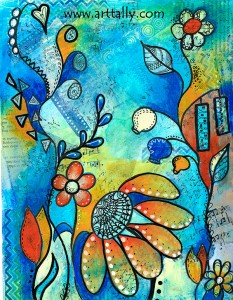 I bet most of the things on your to do list today are useful, important tasks. I bet they are mostly for everyone else. You are planning meals, collecting dry cleaning, meeting your boss’s needs, doing the school run. It’s all good. That’s what we do.
I bet most of the things on your to do list today are useful, important tasks. I bet they are mostly for everyone else. You are planning meals, collecting dry cleaning, meeting your boss’s needs, doing the school run. It’s all good. That’s what we do.
But you need something for you, too. Something just for you, that you do only for fun. Something that doesn’t really matter. Something you are not accountable for. Something you wont be judged on. Something easy, soothing, relaxing. It might even be your secret. But it doesn’t have to be. Like hundreds of chic French women, you might want to get yourself a colouring book.
No, hear me out…. A grown up colouring book. There are more and more of them available. In fact as I write this, the number one bestseller at www.bookdepository.com is Joanna Basford’s Secret Garden. Yes. It’s a colouring book. And guess what number 2 is? Joanna Basford’s orginal colouring book, Enchanted Garden. The top twenty bestselling books at the book depository currently includes no less than 4 adult colouring books.
Think of it as a purposeful activity if you must. A creative kickstart for some, like bestselling author, Joanna Penn. Joanna uses it as a way to get over a creative block and get writing again. It is an easy way to take the pressure off and soothe the muse.
But really, it is therapy. A way to relieve tension and anxiety. It's easier than meditating. Cheaper (and less intrusive) than a counsellor. Sitting down and colouring is pure escapism. It is active meditation. Mindfulness. The world slides by and you hear only the gentle scratch of the pencil tip on the paper. You feel the silky crayon glide satisfyingly over the paper. Glorious colours of your choosing wash the pixels out of your eyes. Who doesn't need a reprieve from those screens?
Remember when you put that first chunky crayon in your toddler’s clumsy fist? We watch our children delight in making marks and relish all that colour. We know it is good for them. That they are playing, learning, growing. As instinctively as they know what to do with the crayon, we know instinctively that we are nurturing them and their creativity. Why do we think we don't need or deserve that anymore?
I would be prepared to bet that you have plenty of juicy art supplies in your house already. You bought them for your children, didn’t you? When you were sitting at that restaurant and whipped out the crayons and paper to entertain your child while your order was prepared, you felt a twinge of longing to join in. A small twinge perhaps… suppressed… but it was there… you know what I am talking about…. You are not the only one - it is exactly how this whole project of mine got started.
So go on - get yourself a colouring book. Raid your kids’ art stash when they are asleep or at school. I can promise it will be fun. You know those scented markers are calling you...
How to get creatively unstuck in 10 minutes
The creative voice is a quiet one. Sometimes, barely a whisper.
I think I'd like to draw. (Or paint, or write, or sing.)
She is earnest, hopeful and painfully shy. So easily shouted down by her noisy big brother's torrent of 'buts'.
But you are rubbish at drawing...
But what would you draw...
But you will make a mess...
But you don't even know where to start or what supplies to use...
But you should be doing something more useful...
Steven Pressfield calls this Resistance. The opposing force that fights our creative tendencies. To me it is the bullying brother of the little creative spirit. Cruel, perhaps, but protective. There to keep the fragile creative soul safe by preventing it from stepping out of its comfort zone or trying anything new.
Being safe is all very well, but it leaves you with a creative block. Recently, I have found out how to get creatively unstuck in 10 minutes.
Rather than bullying that creative spirit into inaction, all it needs are some boundaries. Just like a small child.
I am taking Juliette Crane's online class called 'Bliss', in which Juliette talks about regaining the fun and freedom of creating by doing little 5 or 10 minute paintings. Well, she is quite right.
I had managed to make drawing and painting feel like an overwhelming task that I could not fit into my day for so very many reasons. But adopting this technique of a ten minute journal has really helped. Often it spurs you on to do a bigger project, but even if it doesn't, you have had the delicious little pick-me-up of a quick play with colour and line.
So the rules of my ten minute journal are designed to create a happy, safe and fun place where I can just enjoy the process of drawing and painting, liberated from those 'buts'. They go something like this:
the journal is small (and square which I love, but I don't think it matters!)
the paper is nice enough to take watercolour but not so expensive that I will feel bad about 'messing it up' (life is too short for bad paper, as Jane Davenport would say)
each painting takes 10 minutes
I can only use watercolours and black pens and white pens
colours are limited to a palette of three (yes, I break this rule often... and usually regret it)
each picture includes a character (e.g. a face, a figure, maybe an animal or bird)
The good thing is that these limits are totally liberating. I am using my travel watercolours and a waterbrush so I can do this anywhere - usually on the couch in front of the TV. I don't have to make decisions about what to draw and what materials to use. Each picture is going to be done in 10 minutes so it's never going to be perfect. Some times I love them, sometimes I really don't. Either way it doesn't matter. In ten minutes I will turn the page and forget about it.
Try it and see.
Abandon perfection and just enjoy being creative.
5 Free online art classes
Free online art classes make my heart sing! The online art community is such a generous one. So if you have been thinking about trying something creative but are wondering whether an online art class is for you, I just might be able to help you out.
These are the free classes that I have come across and taken in the last couple of years. Check them out - there might be one that is just right for you.
Art Heart and Healing
Tamara Laporte offers a 4 week mixed media course called Art, Heart and Healing which over 2000 students have taken. As well as learning many mixed media techniques, this class also offers a chance to experience the more therapeutic benefits of art. If that does not appeal, don’t let it put you off the class! Tam has an inclusive, engaging style and manages to pack an enormous amount of art advice and techniques into each lesson. Whether you want to ignore the healing side or not is up to you. And don’t worry if you are new to art, the beginner is well catered for.
Total Alignment
Connie Solera at Dirty Footprints studios offers a free painting course that comprises 5 lessons all aimed at getting you in Total Alignment with your creative source. It is a gloriously liberating journey into fearless painting. This one is for everyone, whether you have never painted before or you have plenty experience but just feel a bit stuck.
I am Free
Marieke Blokland offers a free mini art journalling course, called I am Free. The course has 4 lessons, and gives you a chance to see Marieke’s terrific videos. It is clear that a lot of effort goes into producing them. She's a doll, and I just love her quirky whimsical style!
Finding your muse
Alisa Burke offers a free course all about how to find your muse. I love her straight forward approach. Simple, inexpensive supplies are used, making this a no excuses prompt to get out and draw. This free course has 6 mini lessons and includes some high speed video of Alisa working in her sketchbook - that alone will probably get you motivated - it certainly worked for me! This class is about getting inspired, not about learning art techniques.
Strathmore Online Workshops
Strathmore offer a series of workshops through the year. Unlike the four classes listed above, these classes are not 'permanently' available. The first workshop in 2015 starts on 2 March (Traci Bautista), with other workshops becoming available at the beginning of May (Patti Mollica) and September (Maureen Wilson and Alphonso Dunn). You can go and register now (for free) and join the group for each workshop that takes your fancy.
If you have never taken an online art class before it can be hard to know where to begin. Luckily, some of the best art teachers offer free courses. This is brilliant on so many levels. You get a chance to see whether the online environment works for you. You get to see whether or not you like particular teacher’s style. And the best part is often participating in the class group or forum. I have found the student groups in all these classes to be friendly, welcoming and encouraging. You will probably find some fairly impressive art work there too - don't be intimidated!
"Never compare your beginning with someone else's middle." John Acutt
Art is fun whether you are 2 or 92. You don't even have to be good at it... (whatever 'good' might mean here!) So go on, give it a go. You know you want to.
And by the way, if you come across another free class or have some experience of these ones to share let us know. (If you can't see a comments box below there is a comments link near the heading)
What is art for?
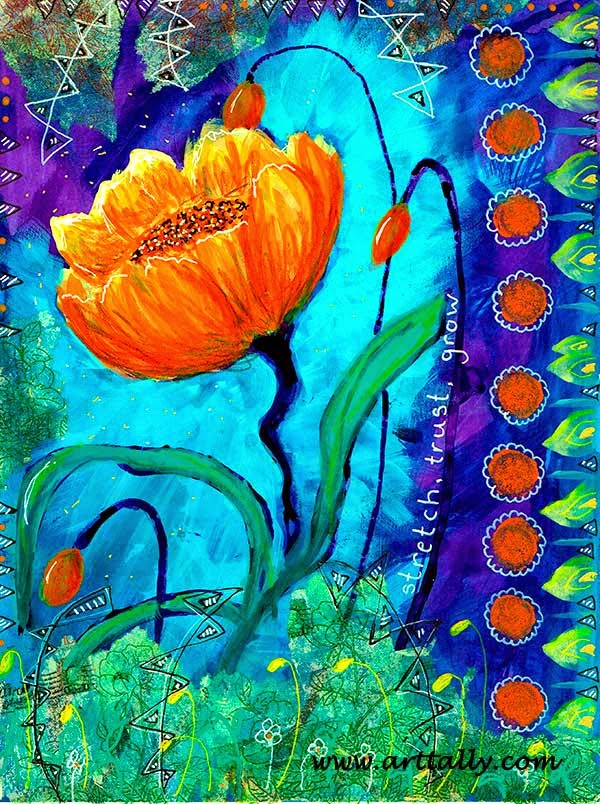 |
| Mixed Media Painting created in the online class 'Lifebook 2014' |
Sometimes I make some art. Maybe a journal, maybe a painting, or just a doodley sketch. Then my Inner Librarian leans over to take a look. "Hmm... " she says. "What is it for?" Thanks to both nature and nurture I am a deeply practical person. Art is fairly new but I have always been compelled to create. And always there is the question... what purpose does each creation have? One conclusion I often draw is that it seems easier to see what art is for if it is good art. But this is not a satisfactory answer at all. I get stuck in a loop of circular logic. 'Good' is subjective. Contextual. So in order to assess whether art is good, I need to know what it is for. Something is 'good' if it does what it is supposed to do. So what is art supposed to do? Alain de Botton has given the matter some thought. I came across this great little video that articulates his optimistic view on the question. It's one of those funny things... most people that make art worry that it is not good enough, and most people that look at art worry that they don't understand it. Perhaps we are all trying too hard.
The purpose of art is washing the dust of daily life off our souls. Pablo Picasso
Inspiration from famous artists: Joan Mirò
 |
| Miro inspired abstract in my sketchbook (following Carla Sonheim's exercise in the book 'Drawing Lab') |
The trouble with being a self-taught artist is that I can’t help wondering what it is that I need to know. What did I miss when I was learning calculus and consolidations instead of being in art class? Something I definitely know very little about is the artists of the past. Drawing Buddy and I made a start on filling this gap a little while ago. You remember Drawing Buddy? She is the one who is working through Carla Sonheim’s Drawing Lab with me. Well, in between all the tea and talking.
Anyway, Carla has a section on famous artists. We started with the Spanish artist Joan Mirò. No particular reason for selecting Mirò to start, but a surprisingly apt choice. Mirò went to business school because his parents advised him to choose a ‘sensible’ career, like bookkeeping. He apparently had a breakdown and consequently abandoned the business world entirely. (I hear you, my brother…) Here are another few fun Mirò facts…
- Mirò was a surrealist painter and sculptor known for using automatic drawing. No, not the paranormal kind – the kind where you allow your hand to make ‘random’ marks on the page. Messages direct from the subconscious, you see. Well, I love starting a doodle like that – didn’t realize it was a Thing.
- Along with Josep Royo, Mirò created the World Trade Center tapestry which was a little over 6m by 10m and weighed about 4tonnes. It hung in the South Tower from 1974 until it was destroyed in 2001
- Mirò’s Painting-Poem sold in 2012 at Christie’s for $26.6million. It includes the words “le corps de ma brune puisque je l'aime comme ma chatte habillée en vert salade comme de la grêle c'est pareil”. Now I know my French is rusty, but that really does say something like ‘the body of my brown since I love it like my cat dressed in green salad like hail it’s the same’, doesn’t it?
 |
| Painting-Poem by Joan Miro (1893-1983) |
Well I still don’t know much about cats dressed in green salad, but I did enjoy making a Miro inspired abstract in my sketchbook. I think I might just do another one.
The painting rises from the brushstrokes as a poem rises from the words. The meaning comes later. (Joan Miro)
Are artists lonely?
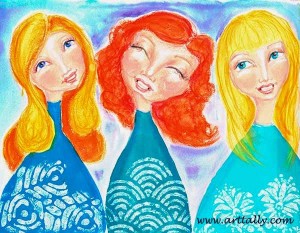 |
| Mixed media journal page created in Jane Davenport's online class 'Frolicaholic' |
I have a Drawing Buddy. We meet once a week and draw and drink lots of tea. (Often more tea than drawing). I am so glad that we do this because I realise how easily I can disappear from the world into art. It has made me wonder whether artists are destined to be rather lonely.
Artists are usually the quiet thinkers. Writing, painting and drawing are solitary pursuits. Most of the time this is good. A chance to escape the noisy rush of life, even if only for a little while.
But does this mean artists are lonely? I think there is a difference between loneliness and solitude. Solitude is a choice.
According to Leo Babauta, solitude is the number 1 habit of highly creative people. He cites both contemporary and historic examples of the artist's need for solitude.
Sarah Lewis also talks about the need for temporarily withdrawing from the world in order to create. Creation comes from our inner private domains. So often we are being told to get our work out where people can see it, being visible and vulnerable. It is easy to forget that there is a need to spend time alone with our thoughts and our art before this can happen. Sarah speaks beautifully about this here, if you have a few minutes to spare.
I have only fairly recently realised how much I need a bit of solitude. But I appreciate in equal measure the chance to meet up with those that share my new found passion for art. I love a Facebook online class group. And I always enjoy my weekly tea and art catch up with Drawing Buddy.
"It is one of the blessings of old friends that you can afford to be stupid with them." Ralph Waldo Emerson
Drawing Buddy and I have each purchased a copy of Carla Sonheim's Drawing Lab for Mixed Media Artists. Each week we pick a Lab to do together. I am finding this book to be a really handy resource. It contains 52 exercises (or labs) which are fairly quick to complete.
- want a warm up activity to get going
- feel stuck and in need of a bit of inspiration
- have a few minutes to spare but are not sure what to draw

